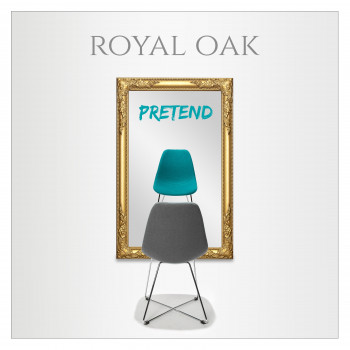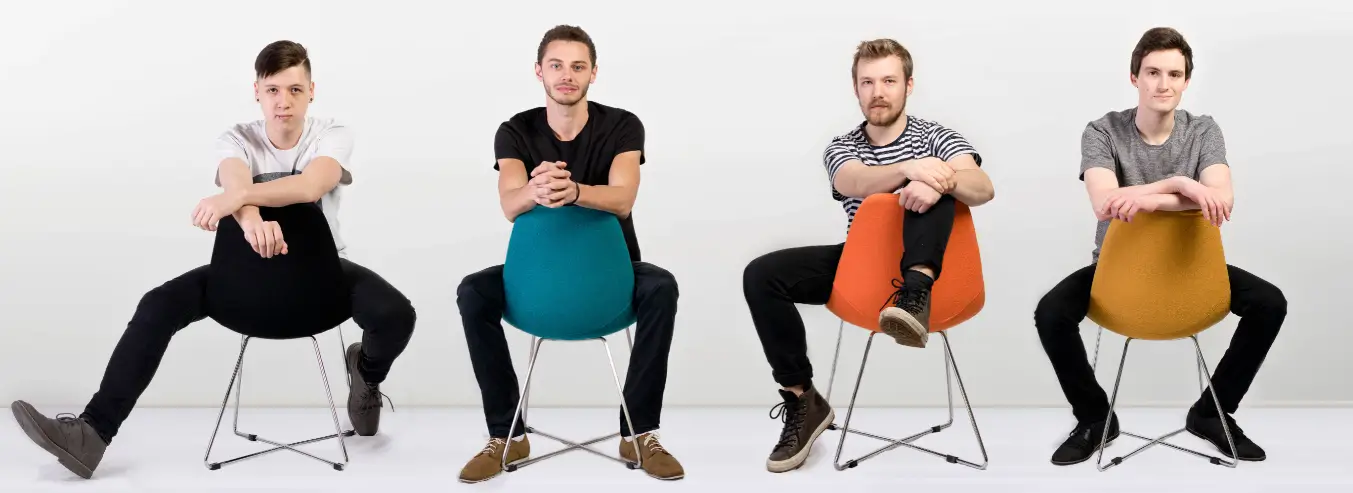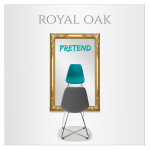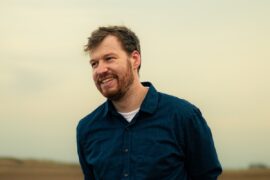Friendship, craft, and making believe remain very much alive in Canadian act Royal Oak’s latest dance-worthy EP, ‘Pretend.’
— —
Where synthpop meets craft meets making believe is where you’ll find Vancouver-based group Royal Oak. Though their tunes, spread across several EPs and LPs, may sound sunny, the work that goes into crafting each song is a world within itself. Each bop has a story to match its sound, whether it channels the energy of synthpop powerhouse The Griswolds or the smallest dash of Bad Suns. And nowhere is that more prevalent than in Royal Oak’s latest EP, Pretend (out 7/20/18), which Atwood Magazine is proud to be premiering today.

Pretend‘s energy matches the season of its release: the EP is perfect for sunny summer days, whether they include hitting the road or psyching up for a night out. Filled with all of synthpop’s trademark exuberance, Pretend is also marked by control, making for a dose of five songs that seem to pair together seamlessly. That structure and flow might be a trickle-down effect from the bond between the members. Between them, you’ll not only find that most members seem to be jacks-of-all-trades (lead vocalist Austin Ledyard also plays guitar and keys, bassist Brayson Wong is also on synth and vocals, Michael Kragelj plays guitar, keys, and vocals, and Myles Philpott is on drums and percussion, plus vocals), but 15 years of friendship. No wonder Pretend sounds so well-crafted; there’s a camaraderie behind the music you can almost hear.
Royal Oak kicks off Pretend with plenty of power in dance-worthy “Tell Me.” ’80s-inspired synth blurs into well-placed guitar as lead vocalist Austin Ledyard asks “Well, you say that we’re in the right place/ Do you know it?” There’s a confidence there, implying that if the other party or listeners might not, Royal Oak definitely knows both where they stand and who they are as a band. The confident, playful “Tell Me” sets the tone for the rest of the album and invites us to get to know Royal Oak…and to get on our feet.
Whirling synth opens “Mistakes,” a tune dedicated to messing up. Featuring Canadian pop chanteuse Chersea, the song becomes complete with its two-sided perspective on past mistakes made.
Despite its upbeat tune, “All Comes Back To You” weaves a story of running away: whether it’s for a weekend with a lover’s best friend or “packing up your suitcase, running for the next train.” The thread of escaping runs through the song, coming to a realization that running from your problems ultimately leads them right back to you. Following “All Comes Back To You”’s strong narrative is “Only One,” a rolling anthem of self-change that fades a bit when compared with the other songs Pretend has to offer. That doesn’t mean it’s any less catchy, though, especially with that bass line.

Closing the EP is “Hold to Nothing.” Though it’s still synth-packed, the lovelorn refrain “you know love will never stay” turns more introspective, reminiscing on a lover long gone. The song doesn’t stray too far into sadness: if anything its heavy percussion and well-worth-waiting-for guitar solo make it more hard-hitting.
Ultimately, what shines through in Pretend is Royal Oak’s carefully-crafted exuberance. Every song was put together with special care, and is held together by the band’s skill and camaraderie, which you can almost hear in their songs. Roll down your windows, crank up Atwood’s exclusive stream and dive in to vocalist Austin Ledyard’s in-depth personal take on each song!
Listen: Pretend – Royal Oak
:: Making Pretend ::

Tell Me
Like many songs these days, this song actually started in the bedroom of my childhood home on my laptop. I was messing around with a virtual emulator of a vintage synth called a Juno 60. I always found the best ideas were the ones I stumbled upon by accident, and this was no different. At the time, I didn’t have a keyboard with me: I was forced to use a thing called keyboard typing, which leaves you with about an octave and a bit of notes. The chorus chord progression was one of the first things I started playing, and it became the basis for what the band and I used for the entire song. The pre-chorus and chorus melodies I actually ended up coming up with in my head in a parking lot while walking into Subway! Inspiration truly comes at the strangest of times.
When our producer Ryan (Worsley) started working with us, he gravitated towards this track right away. He already had great ideas for what the song needed to take it to the next level, and it was really refreshing to have a second opinion and some new ideas flowing in. As a musician, it can sometimes be hard to let go of something you’ve created and let it be what it needs to be. Even if that means the song moves in a direction you may not have thought of, sometimes it’s for the best. It’s a scary feeling, but it’s something that we’ve learned to embrace as songwriters.
Mistakes (ft. Chersea)
Like “Tell Me,” this song started out with me creating this bubbly little synth patch that had a bit of a bounce to it. When we were writing for the EP back in October of last year, I randomly decided to load up that patch I made and played a few chords that ended up being the chorus progression you hear in the actual song. In the finished product, we ended up using the original synth patch in the mix, but it’s very buried behind other pads and the rest of the instruments. It’s interesting that what was the backbone of the song to start with became such a minor piece in the end. It’s another example of doing what’s “best” for a song, and I think that although it’s not very well heard in the song itself, the synth part definitely played its role by being a vehicle for sparking the creative flame. I think that alone makes it one of the most important pieces of the recording overall.
When we started venturing into lyrics, the song already screamed to have two different vocalists. Because of how we’d written it, Brayson ended up piecing together a different chord progression for each verse, which gave a stark contrast to the beginning and middle of the track. From the very start, this song had a very “he said/she said” vibe to it, so it was already the vessel for two different sides of a story. When looking for that second voice, we realized none of the rest of the band would quite cut it, so Ryan suggested that we ask Chersea to take on the vocal duties. Since we had all the parts written for her, all she had to do was come in and sing it, but when she actually came into the studio to record, she added a few ideas of her own and became a solid contributor right off the bat. The whole thing felt right; she was just the thing the song needed. From there, “Mistakes” basically finished itself.
All Comes Back to You
This song started out as a totally different chord progression on a totally different beat as a totally different idea from a while back, and slowly shifted into what it is today. Once we found it, it felt very groovy and right to us; we probably ended up jamming it for about ten minutes trying to feel out any changes as we went. As soon as the song deviated from what it originally started as, it took on a life of its own really quickly. Myles had recently bought this “utility snare” as it’s called (I forget the brand name as of right now) and wanted to try making the beat into something that incorporates two different snares into one song. Eventually the sampled electronic snare and claps were added in the first verse as well for variety.
The lyrics for the song originally stemmed from the chorus, with the line, “When you were gone for the weekend, I ran off with your best friend”. At the time they were meant to be placeholder lyrics, which is where I start a lot of my lyrics when we write: whatever’s on the top of my head. I always told myself that I’d write something else, but never could figure out anything that was of much worth. Eventually I approached the rest of the guys about it and they said that they loved the sort of “shock value” feel it had to it. I mean, who really writes about that? And if so, who would make it so blatantly obvious? Normally as a lyricist, you’re tasked with being a little more tongue-in-cheek and clever with how you say and phrase things. At this point, it became more of a goal to make the lyrics as obvious and as self-presenting as possible. In a way, it’s almost lyrical satire about the unwritten rules of being a lyricist in itself. At the same time, the lyrics to this song are sort of what gave the new EP the name “Pretend”—it’s not an autobiographical song. It’s just made up. In fact, the same could be said for all of these new tunes.
Only One
In the demo stage of this song, it all started with Michael doing this little tapping riff on the guitar in an interesting rhythmic fashion. Myles tossed a simple beat over top of it, Brayson threw a Motown-ish walking bass line throughout it and I added simple keyboard stabs that were drenched in reverb, so that I could stay out of the way of what the rest of the song was doing. Once in the studio, the guitar riff got a LOT of fuzz thrown on top of it, and it got chopped up into pieces to sound sampler-like.
The lyrics for “Only One” were written about a fictional person (see, it’s all pretend) who who sees no wrong in the way they act and the way they treat people, and will blame others instead of themselves when things don’t work out. The lyrics in the pre-chorus of the song are some of my favourite lyrics written for the band so far (“you’re never right, you’re never wrong, you’re never okay/ doesn’t mean you have a reason to be that way”), and I think the rhythm that the pre-chorus has really helps glue together the two separate styles that the verse and chorus have. The pre-chorus is easily one of my favourite parts of any song we’ve written, and the song is a top pick for me as well.
Hold to Nothing
“Hold To Nothing” is one of more experimental and adventurous tracks we’ve written. This song took a lot of time to try and arrange properly. We had the idea for the song very early on, but really wanted to emphasize the dynamic changes in the song to make sure it had maximum impact. Although sorting through those changes was relatively simple, what really took some time was trying to figure out how to pull off the rhythm change in the ending section properly so that it sounded smooth. Brayson originally brought the idea of the rhythmic shift to the table, which we all thought would sound awesome. What we didn’t realize is that it would take a few weeks to actually figure out how to make it work.
I wrote the lyrics for the song based on the concept of a failing relationship. I wanted to really paint a backdrop of hopelessness and desperation for things to be okay again. Think of it like a longing for what once was. When I write lyrics, I normally bounce them off of Michael once I have something I’m happy enough with and then we critique back and forth. He really gave me some good ideas on how to refine the words and be a little more visual with the lyrics. At the end of the day, I think, we achieved what we wanted to portray—which I think suits the song perfectly.
— —
:: stream Pretend here ::
— — — —

Connect to Royal Oak on
Facebook, Twitter, Instagram
Discover new music on Atwood Magazine
? © Mackenzie Cholowski








